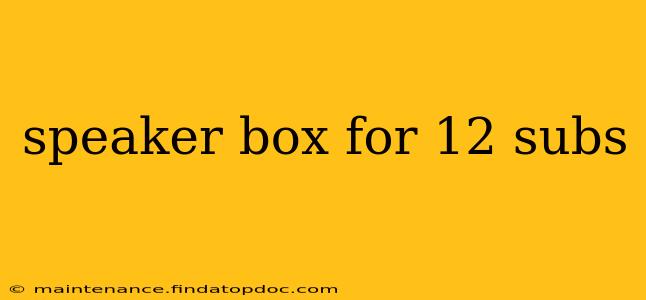Designing a speaker box for 12-inch subwoofers is a crucial step in achieving optimal audio performance. A poorly designed enclosure can severely limit your subwoofer's potential, resulting in weak bass, distortion, and overall poor sound quality. This guide will walk you through the key considerations and calculations needed to build a high-performing enclosure for your 12" subs.
What Type of Enclosure is Best for 12-Inch Subwoofers?
The best enclosure type depends heavily on your desired sound characteristics and the subwoofer's specifications. There are several common options, each with its own strengths and weaknesses:
-
Sealed (Acoustic Suspension): Sealed enclosures are relatively simple to build and offer tight, accurate bass with good transient response. They're less prone to port noise and are often preferred for smaller spaces or applications where precise, controlled bass is prioritized. However, they generally produce less overall output than ported boxes.
-
Ported (Bass Reflex): Ported enclosures utilize a port (tube) to enhance bass output at specific frequencies. They can deliver significantly more output than sealed enclosures, especially in the lower frequencies, but they require careful design to avoid unwanted resonances and port noise. They can also sound "boomy" if not properly tuned.
-
Bandpass: Bandpass enclosures are more complex and offer a very narrow frequency response, maximizing output within a specific range. They are generally used in high-powered, specialized audio systems. They require precise calculations and are not recommended for beginners.
-
Horn: Horn-loaded subwoofers are highly efficient and can produce extremely loud bass, but they require significant space and expertise to build. They are typically used in professional sound systems.
What are the Key Considerations When Designing a Speaker Box?
Several factors must be considered when designing the perfect enclosure for your 12" subwoofer(s):
-
Subwoofer Specifications: Consult your subwoofer's specifications for its recommended enclosure volume, tuning frequency (for ported boxes), and other relevant parameters. This is crucial for achieving optimal performance. Ignoring these recommendations can damage your subwoofer.
-
Enclosure Volume: The internal volume of the enclosure significantly affects the bass response. Too small, and the bass will be weak and distorted. Too large, and the bass will be loose and uncontrolled.
-
Port Tuning (for Ported Enclosures): The port's length and diameter determine the tuning frequency of the ported enclosure. Proper tuning is crucial for maximizing output and minimizing distortion.
-
Material Selection: The enclosure material should be sturdy and capable of handling the subwoofer's vibrations. Common materials include MDF (Medium-Density Fiberboard), plywood, and even hardwood. MDF is a popular choice due to its stiffness and dampening properties.
-
Internal Bracing: Internal bracing helps to reinforce the enclosure and reduce unwanted vibrations, improving sound quality.
-
Damping Material: Adding damping material (such as acoustic foam) inside the enclosure can help to absorb unwanted resonances and improve the overall sound.
How Do I Calculate the Required Enclosure Volume for My 12-Inch Subwoofer?
The required enclosure volume is often specified by the subwoofer manufacturer. This is the most important piece of information. If it isn't provided, you'll need to consult subwoofer modeling software or online calculators. These tools allow you to input the Thiele-Small parameters (TS parameters) of your subwoofer to determine the optimal enclosure volume for different enclosure types. Improper calculation can lead to sub-par sound.
What is the Proper Port Length for a Ported Enclosure?
The port length is critical for a ported enclosure. Incorrect length will result in unwanted resonances and distortion. Online calculators and subwoofer modeling software use the subwoofer's TS parameters and the desired tuning frequency to calculate the ideal port length and diameter.
What are the Different Types of Ports Used in Subwoofer Enclosures?
Several port types are available, each with its own characteristics:
-
Round Ports: The most common type, easy to manufacture and calculate.
-
Slot Ports: Offer a more streamlined design and can be tuned for lower frequencies than round ports of the same length.
-
Flare Ports: Tapered ports that minimize turbulence and improve airflow at higher volumes.
Conclusion
Building a high-performing speaker box for 12-inch subwoofers involves careful planning, accurate calculations, and a good understanding of acoustics. By understanding the different enclosure types and following the steps outlined above, you can create an enclosure that maximizes your subwoofer's potential, resulting in powerful, clean, and enjoyable bass. Remember to always consult your subwoofer's specifications and consider using subwoofer modeling software for accurate calculations, especially when dealing with ported enclosures. Proper research and planning will avoid costly mistakes and help you achieve your desired audio experience.
